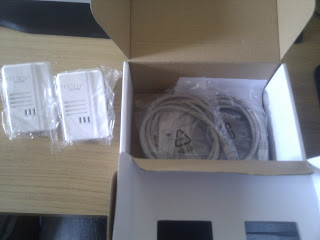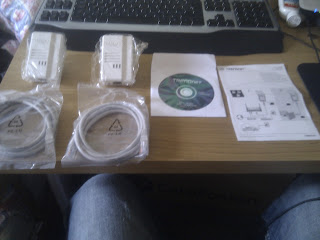I recently moved house and I had to fudge a network connection together. Here is an artist's rendition of how I set it up.
Beautiful, isn't it?
Due to the model of router I had, it could not be set up on the same subnet wirelessly, meaning other devices on the network could not see my PC (such as the PS3 connected to the HomeHub). Also, this solution generated yet more wireless traffic in an already congested area.
So to replace the orange magic wireless lines in the image above, I bought a set of powerline adaptors. Saw these ones from TRENDnet for £20. Good price.
ALL THE INFORMATION EVER. If I'm honest, a lot of this is gibberish to me or totally irrelevant.
Brief description of use and big pictures. Multiple language instructions, just in case.
Let's open this bad boy up.
Neatly packed up, individually wrapped. You can be assured these will probably not be damaged in transit.
One thing I didn't know before removing the plugs is that they came with some CAT5e patch cables. Bonus for £20! Not too long, but the devices are designed to avoid masses of cables everywhere, so it's a good thing.
Here we see everything. Multi-lingual instructions, software disk, 2 x plugs and 2 x cables. What more do you need?
Good ol' indicator LEDS. You know if PWR doesn't come on you are gonna have a bad time.
RJ45 connector. What more could you want? The sync button is also here, used for resetting the encryption on the device. Would have been nice to have this on the front of the plug to make it more accessible, but at least here you can't accidentally prod it while messing blindly behind your computer changing cables or something.
Setting up the devices was very easy. I plugged both devices into a double wall socket. Both devices then powered up and instantly connected to each other. It turns out they come set with the default key, so to checked they worked I set up the network and disabled the wireless bridge. BOOM! Internet and (with a quick trip to the router's set up page) on the same subnet as the HomeHub. Excellent.
With the test over, I got both plugs back in the same wall socket to scramble the key. Very easily done, just hold Sync for 10 seconds on one, then 10 seconds on the other. All done. It is worth pointing out that you don't have to have them in the same socket to sync them; I did it so I didn't have to dash between the 2 devices (you have 120 seconds to hold Sync on the device after starting the process).
Well, lets have a look at some Pingtest results, shall we? Before and after:
Now you know something is wrong when the server is RECEIVING more packets than I've sent. Bad bad bad.
That's more like it. I am also no longer limited by any slow devices on the wireless, as well as generating less wireless traffic. Personally I prefer to use wires when possible; it's good for phones, tables and laptops but for consoles and PCs you should really use a cable unless it is absolutely impossible to do so.
I attempted to install the supplied software... but it didn't seem to work on my machine. Looking online, I found out that it can't detect the plug unless the machine the software is on is connected directly it. But as I have found out, the software is not needed to get these cheap plugs to work.
Sadly, after buying these plugs the place I got them from sold out and they are no longer listed. However, more well known companies like Belkin and TPLink do their own versions, but you'll be paying more that £20 for them.
If you plan to have more that 2 of these in a house, make sure they support 500Mb. While each device can only do 100Mb down the CAT5e cable, the devices still have to talk to each other. However, if you can't stretch your budget enough for them and only want 2, a twin pack will do you just fine. If your house wiring is up to scratch. If your wiring is crappy, Your Mileage My Vary.










